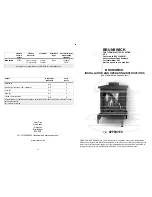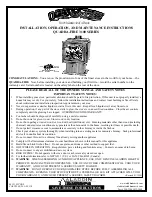
10
flue pipe must be swept at least once a year.
To avoid a build up of soot on the baffle (the plate inside the stove above the grate)
this must be removed and cleaned periodically. This plate locates the back and side
firebricks so note its position before removal. To remove, lift plate and remove one
side brick, this will allow plate to drop and aid removal. To replace, position baffle plate
on back and side brick, lift plate and replace remaining brick, make sure it has located
in position. This must be done when the stove is cold.
For efficient burning of your appliance, make sure the grate is clear of burnt debris i.e.
nails etc.
Troubleshooting
1)
Poor heat output
A) Stove too small for a room.
Seek advise from a Qualified Heating Engineer as to (KW) output required for
room size as a guideline the volume of the room in cubic feet divided by 500 i.e.
room 15’x15’x8’ would require 3.6kw approx.
B) Chimney and/or flue pipe restricted, room ventilation restricted.
On installation these will have been checked but regular maintenance is neces-
sary as conditions can change i.e. soot build up, birds nesting, masonry fall,
dust build up or furniture blocking vents.
C) Poor quality fuel.
Only burn dry seasoned timber, soft woods have a lower heat output then hard
woods per hour. Solid fuels vary in heat value check with your coal merchant as
to suitability.
2) Dirty Glass Panel
A) Generally caused by poor fuel quality, see (1c)
B) Use secondary air slide (Airwash) for glass panel
C) Fire burning to low, open air vents on stove create hot fire this may ‘burn’ glass
clean.
D) If glass requires cleaning use glass cleaner recommended by your supplier,
only use glass cleaner or cold glass. DO NOT USE any abrazifs or scrapers these
will scratch glass causing tar build up harder to remove.
3) Unburnt Fuel In Firebox
Insufficient air reaching fuel. Open primary air slide, this will supply combustion air
to burn fuel fully (unless it has reached a ‘point of return’)
Check ash pan is full, empty if required, grate may be blocked de-ash with riddler,
check for jammed clinker or nails in grate when fires out and cold.
4) Smoke And Fumes Entering Room
These are very dangerous and must NOT be tolerated. Open window and allow
fire to burn out, seek expert advice immediately. DO NOT USE stove until the
7
Notes On Solid Fuel Burning
Always de-ash before refuelling and do not let the ash build up to the underside of the
grate bars. Solid fuel produces ash, which if allowed to build up will stifle the air flow
through the grate and eventually cause the fire to die.
With some solid fuels a residue of burnt fuel or clinker will accumulate on the grate, al-
low the fire to go out periodically to remove this.
We cannot stress firmly enough how important it is to empty the ash pan regularly. Air
passing through the firebed cools the grate. Distortion or burning out the grate bars is
nearly always caused by ash being allowed to build up the underside of the grate.
Recommended Fuels
Seasoned wood—moisture content less than 20%
Solid fuel—Anthracite large nuts, briquette smokeless fuel i.e. Ancit, Phurnacite, Tay-
brite, Homefire Ovals suitable for closed appliances.
Please note that when refuelling with solid fuel do not pile fuel higher than 30 degrees
from the front bar rearwards—overfuelling can produce temperatures beyond the de-
signed rating of the appliance, causing damage to internal parts.
Lighting The Stove
We recommend that you have two or three small fires before you operate your stove to
its maximum heat output. This is to allow the paint to cure and castings to relax and con-
solidate location we recommend ‘running in’ procedure after long shutdowns to preserve
life of stove. During this you may notice an unpleasant smell. It is not toxic, but for your
comfort we would suggest that during this period you leave all doors and windows open.
First, load the fire with starting fuel i.e. paper, dry kindling timber and/or fire lighters in
the mode chosen, either wood or coal.
Light the fire at base leaving all air controls open. Allow the fuel to reach a steady glow
and build the fire up gradually. Once you have a good fire established across the grate
bed, further fuel can be added as required.
When your fuel is well alight you can start to restrict the primary air intake. If you are
burning only wood, the primary air control can be fully closed. If you are burning solid
fuel you will require more primary air. Your stove is burning with maximum efficiency
when a bright fire is achieved using minimum air inlet.
The stove can be banked up for long periods. When burning solid fuel empty the ash-
pan. Open air controls and let the fire burn brightly for a short period. Refuel and close
air controls, the exact setting required will depend on the fuel used and the chimney
draw so some practice may be necessary. To revive the fire, open air controls until the
fire is burning brightly, de-ash if necessary (solid fuel only) and refuel. Set air controls as
required.
This appliance is designed to be operated with the door closed. Except for refuelling, not
only is it unsafe to operate with the door open but the appliance efficiency will be re-
duced dramatically.


























